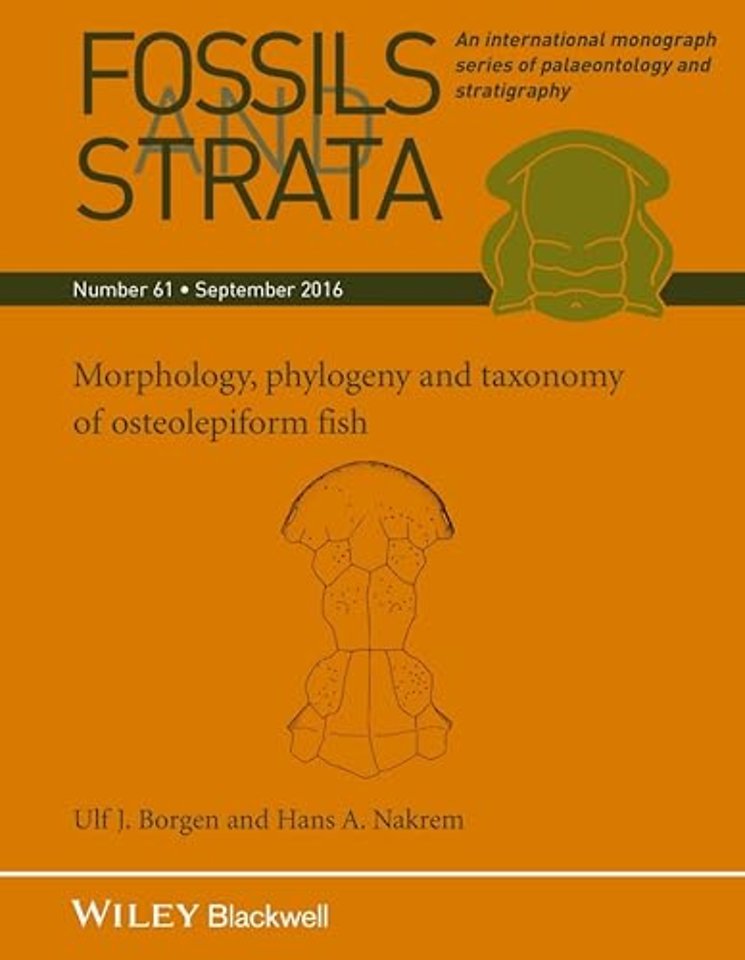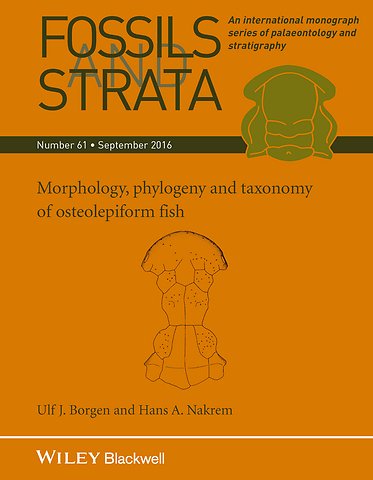Fossils and Strata, Number 61, Morphology, Phylogeny and Taxonomy of Osteolepiform Fish
Morphology, Phylogeny and Taxonomy of Osteolepiform Fish
Specificaties
Inhoudsopgave
<p>General taxonomy 2</p>
<p> Crossoptgerygii and Rhipidistia 2</p>
<p>Osteolepiform subdivisions 3</p>
<p>Terminology 4</p>
<p>Cranial roof 4</p>
<p>Endocranium 13</p>
<p>Dermal bones in mouth roof 13</p>
<p>Lower jaw 14</p>
<p>Operculo–gular bones 15</p>
<p>Upper Palaeozoic fossil locality in the Oslo Region 16</p>
<p>Stratigraphy 16</p>
<p>Descriptions 18</p>
<p>Material, methods and repository 18</p>
<p>Genus Askerichthys n gen 20</p>
<p>Askerichthys heintzi n sp 20</p>
<p>Genus Megalichthys Agassiz, 1835 62</p>
<p>Megalichthys cf M hibberti Agassiz, 1835 62</p>
<p>Megalichthys pygmaeus Tranquair, 1879 97</p>
<p>Megalichthys syndentolaminaris n sp 99</p>
<p>Genus Latvius Jarvik, 1948 100</p>
<p>Latvius grewingki (Gross, 1933) 101</p>
<p>Latvius deckerti Jensen, 1966 114</p>
<p>Latvius sp Jensen, 1966 121</p>
<p>Latvius cf L niger Jensen, 1973 128</p>
<p>Genus Osteolepis Agassiz, 1835 130</p>
<p>Osteolepis macrolepidotus Agassiz, 1835 131</p>
<p>Genus Gyroptychius McCoy, 1848 131</p>
<p>Gyroptychius milleri (Jarvik, 1948) 131</p>
<p>Gyroptychius groenlandicus Jarvik, 1950a 141</p>
<p>Morphologic comparisons and discussions 160</p>
<p>Fronto–ethmoidal shield 160</p>
<p>General shape 160</p>
<p>Interpremaxilla 162</p>
<p>Composition of naso–rostro–premaxillary complex 162</p>
<p>Shape of upper mouth margin 165</p>
<p>Anterior palatal (premaxillary and rostral) teeth and palatal processes 166</p>
<p>Defi nitions and occurrences of morphotypes of anterior palatal teeth 166</p>
<p>Tooth replacement and evolutionary relationship between the anterior palatal dental morphotypes 167</p>
<p>Number of premaxillary teeth 169</p>
<p>Systematic significance of anterior palatal teeth 170</p>
<p>Anterior palatal processes 171</p>
<p>Postrostrals 172</p>
<p>Variation and trends in postrostral pattern 172</p>
<p>Taxonomic significance of postrostral pattern 176</p>
<p>Nasals 178</p>
<p>Number of nasal bones 178</p>
<p>Positions of the bones in the nasal series 178</p>
<p>Circumnarial dermal bones and supraorbitals 180</p>
<p>Variation in eusthenopterids 180</p>
<p>Reconstructing the circumnarial pattern in Osteolepis macrolepidotus 186</p>
<p>Reconstructing the pattern of supraorbitals in Osteolepis macrolepidotus 188</p>
<p>Circumnarial and supraorbital pattern in other Devonian osteolepiforms 189</p>
<p>Homologizations of circumnarial bones in Megalichthys hibberti, Ectosteorhachis, Askerichthys and Cladarosymblema 191</p>
<p>Supraorbito–tectal series of panderichthyids 196</p>
<p>Frontals and dermosphenotics 197</p>
<p>Shape and composition of frontals 197</p>
<p>Shape, positions and extension of dermosphenotic bones 199</p>
<p>Fenestrae 199</p>
<p>Position of nasal fenestra 199</p>
<p>Shape of nasal fenestra 200</p>
<p>Processus dermintermedius 201</p>
<p>Tubercles in nasal fenestra 202</p>
<p>Presence or absence of pineal openings 202</p>
<p>Position of pineal foramen 203</p>
<p>Shape of pineal openings 204</p>
<p>Size of pineal fenestra and presence of pineal plates 204</p>
<p>Sensory canals 204</p>
<p>Pitlines 205</p>
<p>Parietal shield 206</p>
<p>Relative lengths of fronto–ethmoidal and parietal shields 206</p>
<p>Shape of parietal shield 207</p>
<p>Proportions 207</p>
<p>Protruding posterior margin 209</p>
<p>Position of spiracular incision 212</p>
<p>Relative length of the spiracular incision 213</p>
<p>Parietals 214</p>
<p>Shape of parietals 214</p>
<p>Parietal structures 214</p>
<p>Intertemporals 215</p>
<p>Shape of interpemporal 215</p>
<p>Anterior intertemporal margin and process in post–Devonian taxa 216</p>
<p>Anterior intertemporal processes in Devonian forms 222</p>
<p>On the function of the intracranial joint 223</p>
<p>Lateral shelf of intertemporal 223</p>
<p>Ventral surface of intertemporal 224</p>
<p>Supratemporals 228</p>
<p>Shape 228</p>
<p>Ventral surface and lateral margin 228</p>
<p>Spiracular structures 231</p>
<p>Extension of the spiracular opening 231</p>
<p>Types of spiracular openings 232</p>
<p>Possible muscle insertions around the spiraculum 233</p>
<p>Extratemporal (= postspiraculars) 236</p>
<p>Sensory canals 236</p>
<p>Course of sensory canal 236</p>
<p>Position of canal openings 237</p>
<p>Pitlines 238</p>
<p>Extrascapulars238</p>
<p>Dermal palatal bones 239</p>
<p>Vomers 239</p>
<p>Review of taxa with known vomers 239</p>
<p>Transverse tusk positions on anterior vomers 243</p>
<p>Configuration of anterior vomers 244</p>
<p>Extensions and proportions of the posterior vomer 245</p>
<p>Dental lamina and teeth 245</p>
<p>Intervomerine Canals 246</p>
<p>Evolution of the vomers 247</p>
<p>Parasphenoid 248</p>
<p>Division of the parasphenoid 248</p>
<p>Paraspenoid dental plate 248</p>
<p>Buccohypophysial foramen 250</p>
<p>Pars anterior of parasphenoid 250</p>
<p>Parasphenoid shelves and processi ascendens 250</p>
<p>Foramina on the shelf 253</p>
<p>Acrochordal depressions, additional dermal bones and basicranial muscles 254</p>
<p>Occurrence of acrochordal depressions 254</p>
<p>Function of acrochordal depressions 255</p>
<p>Endocranium 258</p>
<p>Ethmosphenoid 258</p>
<p>Proportions of ethmosphenoid 258</p>
<p>Subethmoidal fossae 258</p>
<p>Nasobasal canal and palatonasal canal 261</p>
<p>Internal structures of nasal capsule 261</p>
<p>Postnasal wall 263</p>
<p>Orbitosphenoid wall of eusthenopterids 268</p>
<p>Comparing orbitosphenoid region of Ectosteorhachis foordi with other cyclolepidoids than eusthenopterids 271</p>
<p>Orbitosphenoid in Osteolepidoidei and other forms 273</p>
<p>Systematic significance of orbitosphenoid structure 277</p>
<p>Posterior end of orbitosphenoid 277</p>
<p>Otico–occipital 278</p>
<p>Cheek plate 280</p>
<p>Maxilla 280</p>
<p>Shape 280</p>
<p>Ventral margin and tooth distribution on maxilla 282</p>
<p>Postorbital and squamosal 283</p>
<p>Lachrymal 285</p>
<p>Jugal 285</p>
<p>Shape 285</p>
<p>Contact with the orbit 285</p>
<p>Quadratojugal 287</p>
<p>Lower jaw (= mandible) 287</p>
<p>Shape 287</p>
<p>Proportions 287</p>
<p>Anterior notch 288</p>
<p>Antero–dorsal bulb 288</p>
<p>Dorsal margin 288</p>
<p>Positions of dental margin and glenoid notch 290</p>
<p>Retroarticular process 292</p>
<p>External structures 292</p>
<p>Dentary/Infradentary suture 292</p>
<p>Inter–infradentary sutures 294</p>
<p>Dorsal cosmine notch, cosmine corners and postero–dorsal bone margin 295</p>
<p>Horizontal pitline 298</p>
<p>Vertical pitline of infradentary 2 300</p>
<p>Sensory canal 300</p>
<p>Canal course 301</p>
<p>Configuration of canals 301</p>
<p>Dentary 302</p>
<p>Dentary teeth 302</p>
<p>Dentary shelf and dental fossa 307</p>
<p>Coronoids 307</p>
<p>Number of coronoid bones and tusks 307</p>
<p>Replacement of coronoid tusks 312</p>
<p>Relative size of coronoid tusks 313</p>
<p>Relative positions of coronoid tusks 315</p>
<p>Coronoid dental ridge 317</p>
<p>Intercoronoid fossae 321</p>
<p>Anterior mandibular fossa 322</p>
<p>Prearticular 322</p>
<p>Presence of a pars anterior of the prearticular 322</p>
<p>Anteriad extension and configuration of pars anterior of the prearticular 323</p>
<p>Course of the pars anterior of the prearticular 329</p>
<p>Anterior extension of prearticular dental plate 330</p>
<p>Shape of dental plate 331</p>
<p>Prearticular dental plate configuration and teeth 332</p>
<p>Postero–ventral depression 332</p>
<p>Posterior part of prearticular 333</p>
<p>Parasymphyseal dental plate and adsymphysial fossa 333</p>
<p>Occurrence of Parasymphyseal dental plate 333</p>
<p>Shape of Parasymphyseal dental plate 334</p>
<p>Relations of Parasymphyseal dental plate to other bones 334</p>
<p>Adsymphysial fossa 338</p>
<p>Infradentaries 341</p>
<p>Infradentary surfaces 341</p>
<p>Posterior extension of infradentaries 341</p>
<p>Meckelian bone 342</p>
<p>Pars mentomandibularis 342</p>
<p>Ventral exposures 342</p>
<p>Pars articularis 342</p>
<p>Foramina 343</p>
<p>Sensory canal foramina 343</p>
<p>Foramina for nerves and vessels 344</p>
<p>Sensory canal pore patterns 350</p>
<p>Distribution patterns of sensory pores 350</p>
<p>Pore distribution as an age indicator 350</p>
<p>Evolution of pore dispersion 353</p>
<p>Taxonomic significance of pore number and distribution 355</p>
<p>Size and types of sensory pits 357</p>
<p>Operculo–gular complex 357</p>
<p>Median gular 357</p>
<p>Principal gulars 360</p>
<p>Submandibulars 362</p>
<p>Opercular and subopercular 365</p>
<p>Shoulder girdle 367</p>
<p>Scapulocoracoid 367</p>
<p>Dermal shoulder girdle 368</p>
<p>Fins 369</p>
<p>Caudal fin 369</p>
<p>Position of fins 370</p>
<p>Scales, body proportions and vertebrae 370</p>
<p>Scales 370</p>
<p>Scale distribution 370</p>
<p>Scale morphology 371</p>
<p>Body proportions 371</p>
<p>Vertebrae 371</p>
<p>Phylogeny and taxonomy of osteolepiforms 372</p>
<p>Taxonomic concepts and principles 372</p>
<p>Characters 372</p>
<p>Quantitative characters 372</p>
<p>Primitive and derived characters, convergence, parallelism and homoplasy 372</p>
<p>Sufficient, necessary, indicative,single and combined characters 375</p>
<p>Diagnoses 376</p>
<p>A phylogenetic model 377</p>
<p>A systematic model 381</p>
<p>Order Osteolepiformes Berg, 1937 381</p>
<p>Suborder Osteolepidoidei Moy–Thomas & Miles, 1971 382</p>
<p>Family Thursiidae n fam 383</p>
<p>Genus Thursius Traquair, 1888 384</p>
<p>Family Osteolepididae Cope, 1889 388</p>
<p>Subfamily Glyptopominae Goodrich, 1909 389</p>
<p>Genus Glyptopomus Agassiz, 1844 390</p>
<p>Genus Megistolepis Obruchev, 1955 392</p>
<p>Genus Shirolepis Vorobyeva, 1977a 393</p>
<p>Genus Greiserolepis Vorobyeva, 1977a 394</p>
<p>Subfamily Osteolepidinae n subfam 396</p>
<p>Genus Osteolepis Agassiz, 1835 396</p>
<p>Genus Latvius Jarvik, 1948 397</p>
<p>Genus Gogonasus Long, 1985b 400</p>
<p>Genus Geptolepis Vorobyeva & Lebedev, 1986a 403</p>
<p>Genus Peregrina Vorobyeva & Lebedev, 1986b 404</p>
<p>Family Megalichthyidae Hay, 1902 406</p>
<p>Subfamily Ectosteorhachinae n subfam 412</p>
<p>Genus Ectosteorhachis Cope, 1880 412</p>
<p>Subfamily Megalichthyinae n subfam or Cope, 1940 415</p>
<p>Genus Cladarosymblema Fox, Cambell, Barwick & Long, 1995 415</p>
<p>Genus Megalichthys Agassiz, 1835 415</p>
<p>Subfamily Askerichthyinae n subfam 419</p>
<p>Genus Askerichthys n gen 419</p>
<p>Suborder Cyclolepidoidei n suborder 420</p>
<p>Superfamily Eopodoidea n superfam 420</p>
<p>Family Gyroptychiidae Berg, 1958 Berg 1940 422</p>
<p>Genus Gyroptychius McCoy, 1848 422</p>
<p>Family Panderichthyidae Vorobyeva & Lyarskaya, 1968 429</p>
<p>Subfamily Panderichthyinae n subfam 432</p>
<p>Genus Panderichthys Gross, 1941 432</p>
<p>Genus Livoniana Ahlberg, Luk eviès & Lebedev, 2000 435</p>
<p>Subfamily Elpistosteginae n subfam 435</p>
<p>Genus Elpistostege Westoll, 1938 436</p>
<p>Genus Tiktaalik Daeschler, Shubin & Jenkins, 2006 436</p>
<p>Family Chrysolepididae n fam 438</p>
<p>Genus Chrysolepis Lebelev, 1983 438</p>
<p>Family Eusthenopteridae Berg, 1955 440</p>
<p>Genus Tristichopterus Egerton, 1861 445</p>
<p>Genus Eusthenopteron Whiteaves, 1881 447</p>
<p>Genus Eusthenodon Jarvik, 1952 448</p>
<p>Genus Platycephalichthys Vorobyeva, 1959 449</p>
<p>Genus Jarvikina Vorobyeva, 1977a 452</p>
<p>Genus Marsdenichthys Long, 1985a 453</p>
<p>Genus Spodichthys Jarvik, 1985 455</p>
<p>Genus Notorhizodon Young, Long, & Ritchie, 1992 456</p>
<p>Genus Mandageria Johanson & Ahlberg, 1997 457</p>
<p>Genus Cabonnichthys Ahlberg & Johanson, 1997 458</p>
<p>Genus Heddleichthys Snitting, 2008b 460</p>
<p>Genus Langlieria Clément, Snitting & Ahlberg, 2008 462</p>
<p>Superfamily Parapodoidea n superfam 463</p>
<p>Family Medoevididae n fam 463</p>
<p>Genus Medoevia Lebedev, 1995 463</p>
<p>Family Canowindridae Young, Long & Ritchie, 1992 464</p>
<p>Genus Canowindra Th omson, 1973 465</p>
<p>Genus Beelarongia Long, 1987 466</p>
<p>Genus Koharalepis Young, Long & Ritchie, 1992 467</p>
<p>Superfamily Rhizodontoidea n superfam 468</p>
<p>Osteolepiformes subord indet 468</p>
<p>Family Lamprotolepididae Vorobyeva, 1977a 468</p>
<p>Genus Lamprotolepis Vorobyeva, 1977a 468</p>
<p>Osteolepiformes subord & fam indet 470</p>
<p>Genus Litoptychius Denison, 1951 470</p>
<p>Genus Lohsania Thomson & Vaughn, 1968 471</p>
<p>Genus Sterropterygion Thomson, 1972 472</p>
<p>Genus Megapomus Vorobyeva, 1977a 472</p>
<p>Genus Thysanolepis Vorobyeva, 1977a 474</p>
<p>Genus Viluichthys Vorobyeva, 1977a 475</p>
<p>Genus Mahalalepis Young, Long & Ritchie, 1992 476</p>
<p>Genus Platyethmoidea Young, Long & Ritchie, 1992 478</p>
<p>Genus Vorobjevaia Young, Long & Ritchie, 1992 479</p>
<p>Genus Sengoerichthys Janvier, Clément & Cloutier, 2007 480</p>
<p>Genus Criptolepis Worobjeva, 1975c 481</p>
<p>Acknowledgements 481</p>
<p>References 482</p>
<p>Tables 491</p>
<p>Appendix Abbreviations used in illustrations and tables 506</p>

